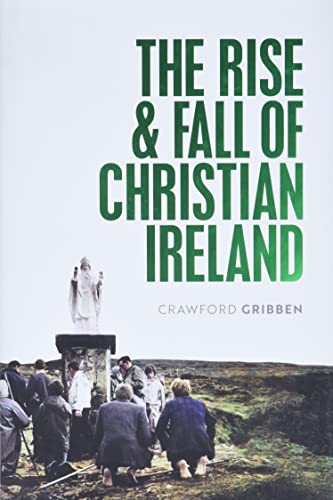
Crawford Gribben
Reviewed by: D. G. Hart
The Rise and Fall of Christian Ireland, by Crawford Gribben. Oxford University Press, 2021. Hardcover, 352 pages, $19.69 (Amazon). Reviewed by OP ruling elder, college professor D. G. Hart.
Just when you thought the history of Christianity in the United States was unusual, maybe even special, along comes Crawford Gribben’s The Rise and Fall of Christian Ireland to break up the party. American Christianity has features that set it apart from churches in other lands. For starters, the creation of a government independent from the church was unusual after almost 1,400 years of established churches. What softened the blow was the greater good of religious freedom for all denominations. These were conditions for a religious marketplace that allowed outlier Protestants, such as Methodists and Baptists, to grow in ways that embarrassed denominations with ties to state churches—namely, Episcopalians, Presbyterians, Reformed, Lutherans, and Roman Catholics. The novelty of American Christianity, consequently, stems from the unusual political order that developed in the United States after 1790.
Ireland, in contrast, yields a Christian story that spans an ancient, indigenous people embracing faith, the efforts of institutional Christianity to consolidate Irish Christians into one body, and an era when serious Christians find themselves in a rapidly secular and hostile social environment. In fact, the arrival of Christianity in Ireland through the efforts of itinerant evangelists mirrors the sort of evangelization that the Apostle Paul conducted four centuries earlier throughout the Mediterranean world. As such, the initial spread of Christianity in Ireland is reminiscent of the early church before either episcopal or imperial authorities held sway. To see Irish Christians emerge from those conditions, and then become pawns (at least sometimes) in the competing jurisdictions of popes, bishops, assemblies, kings, and empire, is to witness a breadth of historical experience that American Christians likely cannot fathom.
Crawford Gribben, a historian at Queen’s University Belfast, who has years of experience studying British Protestantism, is well suited to tell this story. In fact, his own sympathies as an Irishman, who taught for many years at Trinity College Dublin, position him well to recognize and highlight the Irishness of Ireland’s many churches and avoid the temptation to take sides in the Roman Catholic/Protestant divide. His roots in Northern Ireland and experience of Ulster’s sectarian politics and “The Troubles” are additional factors in Gribben’s evenhanded treatment.
Two themes stand out in the book’s narrative. The first is the difference between institutional and indigenous Christianity. In 431, Palladius, who became Ireland’s first bishop, arrived with instructions from Pope Celestine to organize the island’s believers. That chronology—Christians before Rome’s structures—indicates a Christian history that was Irish before it became Roman. Ireland’s first Christians may have been slaves or prisoners of war whose circumstances took them there. This was also a period before the famous work of Patrick, “the apostle of the Irish,” who may have arrived in 432 and whose evangelism is always the first chapter of Irish church history. Although Ireland became part of the Roman pontiff’s administration of church life, the Irish always retained a measure of independence. In the sixth century, the Irish church was part of a dispute about when to date Easter and, though Irish bishops may have followed Rome’s rules, not all of Ireland’s monasteries did. Almost a millennium later, Ireland was still showing its independence by ordaining married priests and observing its own liturgical forms. Columba, the sixth-century founder of a monastic brotherhood was another source of Ireland’s independence. His followers nurtured a Gaelic strain of Christianity up the west coast of the island into Scotland and the Hebrides islands.
The second significant theme is the interplay between Christianity and politics. Some of Irish Christianity’s independence was part of an effort to preserve indigenous forms of devotion over against Rome’s powers. By the time of the Reformation, however, identification with Roman Catholicism became a vehicle for the Irish people to resist English (but also Scottish) Protestantism. By the 1922 formation of the Irish Republic (in the South), followed by its 1937 Constitution, Ireland had become a Christian nation. Its constitution opened with an affirmation of the Trinity, and the state’s social services depended on Roman Catholic agencies administered by bishops (especially health care and education). In the Protestant North, the provincial government was also committed to maintaining a Protestant society, though the diversity of denominations and Protestantism’s own distinction between church and civil institutions made Northern Ireland less overtly churchly than the South. But both the North and South’s commitment to a Christian society, as Gribben explains, made secularization after 1990 more dramatic than in other western societies. Revelations about sexual abuse among clergy (and other scandals) have turned the Republic of Ireland into one of the most secular nations in Europe. In the North, people remain devout, but civil institutions are abandoning Christian norms under the banners of freedom and toleration.
Gribben’s valuable and moving history may not be an obvious choice for American Presbyterian readers. But because of the contribution of Ulster Presbyterians to the American church—Francis Makemie, the so-called Father of American Presbyterianism, came from Northern Ireland—Gribben’s book should be instructive. For anyone who wants to consider the role of Christianity in the West, the test case of Ireland is as fascinating as it is instructive.
December 14, 2025
December 07, 2025
November 30, 2025
November 23, 2025
November 16, 2025
November 09, 2025
November 02, 2025
© 2025 The Orthodox Presbyterian Church